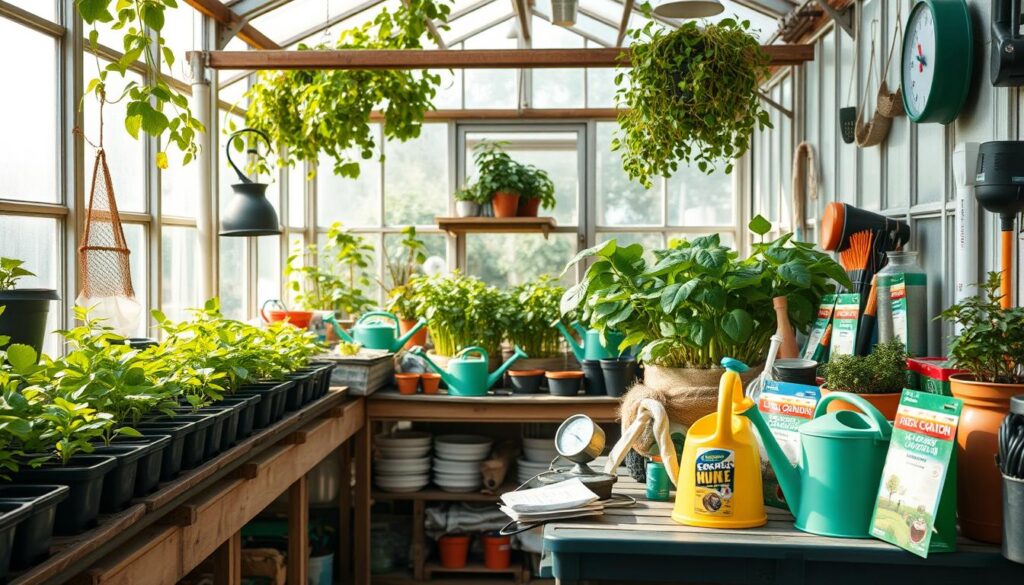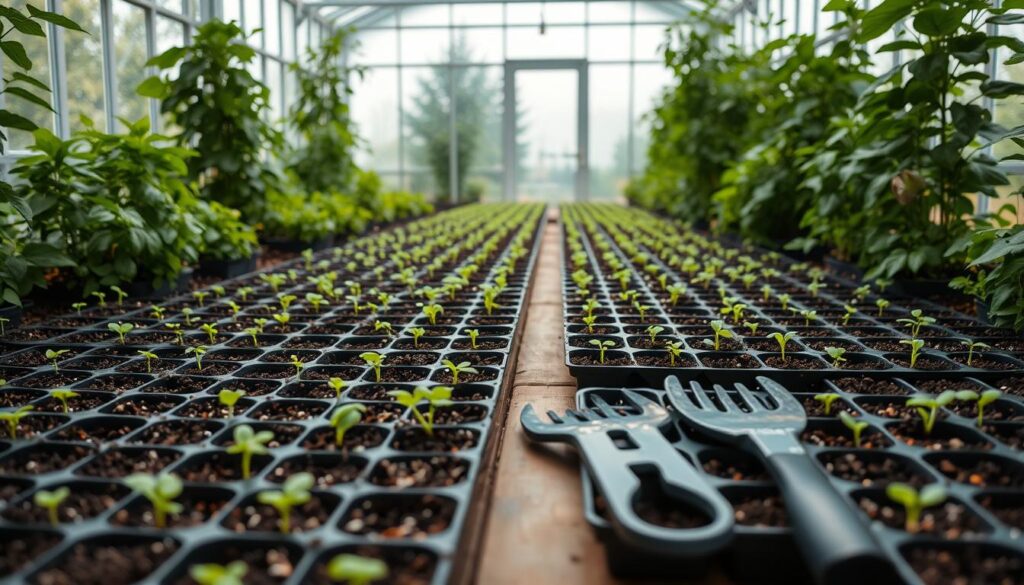I’m excited to share my knowledge on greenhouse gardening. It’s a way to grow plants all year, even when it’s cold or rainy outside. By using technology and controlling the environment, we can make our indoor gardens as lush and productive as outdoor ones.
Greenhouse gardening has many benefits. It helps control pests, increases plant yields, and lets us grow plants that are hard to find. By adjusting temperature, humidity, and light, we can make sure our plants are happy, no matter the weather. It’s a great hobby for anyone, whether you’re new to gardening or have been doing it for years.
Key Takeaways
- Greenhouse gardening allows for year-round plant cultivation and protection from adverse weather conditions.
- Greenhouses enable precise control over temperature, humidity, and light, enabling the growth of a wide variety of plants.
- Greenhouse gardening offers advantages such as pest control, increased yield, and the ability to grow exotic or out-of-season plants.
- Greenhouse structures can range from affordable DIY models to high-end, custom-built designs, with installation costs varying accordingly.
- Proper greenhouse management, including temperature regulation, ventilation, and equipment selection, is crucial for successful plant cultivation.
Getting Started with Your Greenhouse Structure
Building a greenhouse is an exciting step in your gardening journey. The first important decision is where to put your greenhouse. Look for a spot with lots of sunlight, away from strong winds, and close to water and power. A flat, well-drained area is best, and facing east-west helps get more sunlight in northern places.
Choosing the Perfect Location
When picking a spot for your greenhouse, think about a few things:
- Sunlight: Pick a place that gets at least 6 hours of direct sunlight a day for plants to grow well.
- Wind protection: Put your greenhouse where it won’t get hit by strong winds to keep it safe and stable.
- Accessibility: Make sure you can easily get to the greenhouse for upkeep and picking crops.
- Proximity to utilities: Place it near water and electricity for your irrigation and climate control systems.
Types of Greenhouses for Home Gardening
There are many greenhouses to choose from for your garden:
- Freestanding Greenhouses: These stand-alone greenhouses give you lots of room to grow and can be tailored to fit your yard.
- Lean-to Greenhouses: These attach to a wall or structure, saving space and protecting from wind and weather.
- Portable Greenhouses: Light and easy to set up, portable greenhouses are great for small gardens or tight spaces.
Size and Space Considerations
The right size greenhouse depends on what you want to grow and how much space you have. Here’s a rough guide:
| Intended Use | Recommended Greenhouse Size |
|---|---|
| Commercial Growers | Enough room for profitable crops |
| Average Family | 20 to 25 square feet per person for veggies |
Planning your greenhouse layout well can help you use your space wisely and grow a great indoor garden.
Essential Equipment and Tools for Greenhouse Success
Starting your greenhouse gardening journey needs more than just a strong structure. You’ll need the right equipment and tools for thriving plants and a good harvest. From watering systems to temperature control, let’s look at what you need for success.
First, think about shelving or benches. They give space for seedlings, potted plants, and more. An irrigation system, whether manual or automated, keeps plants hydrated. Tools like thermometers and humidity monitors help control the perfect growing conditions.
Lighting is key for plant growth. Your greenhouse can use natural sunlight or grow lights. These lights, like LED or fluorescent, help plants grow even in short winter days.
Keeping the temperature right is crucial. Heaters, fans, and ventilation systems help control the climate. This protects plants and promotes growth. Automated systems make it easier to manage the greenhouse.
A good toolkit is also important. You’ll need tools for soil, planting, and care. Things like trowels, shovels, and pruning shears make maintenance easy.
With the right tools and technology, greenhouse gardening opens up new possibilities. Whether you’re new or experienced, these essentials will help your greenhouse thrive. Enjoy the journey and watch your plants grow with the right equipment.
| Greenhouse Equipment and Tools | Description |
|---|---|
| Shelving and Benches | Provide ample space for plant growth and organization |
| Irrigation Systems | Ensure consistent watering for healthy plants |
| Thermometers and Humidity Monitors | Help maintain optimal growing conditions |
| Greenhouse Lighting | Includes natural sunlight and supplemental grow lights |
| Temperature Control Devices | Heaters, fans, and ventilation systems for climate regulation |
| Gardening Tools | Trowels, shovels, pruning shears, and cultivators for maintenance |

Investing in the right equipment and tools is key for a successful greenhouse. Start your journey and let your greenhouse dreams grow.
Greenhouse Gardening Basics: A Beginner's Guide
Starting Seeds and Propagation
Greenhouse gardening is great for starting seeds and growing plants. It helps seeds germinate well and grow strong. You can choose from hybrid, heirloom, or open-pollinated seeds for your garden.
By using cuttings or grafting, you can grow more plants. This method uses the greenhouse’s stable conditions to your advantage.
Soil Preparation and Amendments
Soil quality is key for a good greenhouse garden. First, test the soil’s pH and nutrient levels. Then, add organic matter like compost or manure to make it fertile.
This creates a soil that’s just right for your plants. Make sure to spread the amendments evenly for even growth.
Watering Systems and Techniques
Watering well is important in a greenhouse. Look into drip irrigation or soaker hoses to water roots directly. This avoids wet leaves.
Keep an eye on soil moisture and adjust watering as needed. Consider the plant type, growth stage, and greenhouse conditions. Learning how to water right saves water and keeps plants healthy.
| Seed Type | Pros | Cons |
|---|---|---|
| Hybrid |
|
|
| Heirloom |
|
|

“Greenhouse gardening allows me to extend my growing season and experiment with a wider variety of plants. The controlled environment is a game-changer for my seed starting and plant propagation efforts.”
Temperature and Climate Control
As a greenhouse gardener, keeping the right temperature and humidity is key. This means using good heating systems when it’s cold and cool methods when it’s hot. Also, having proper ventilation is crucial for air flow, temperature, and humidity control.
Automated climate control systems help keep conditions steady day and night. Knowing what temperature and humidity your plants need is also important. Using shading, misting, and thermal screens can help manage the climate for your plants.
Mastering climate control in the greenhouse helps my plants grow well, no matter the weather outside. With the right mix of heating, cooling, and ventilation, I create the perfect environment for my garden to thrive.






